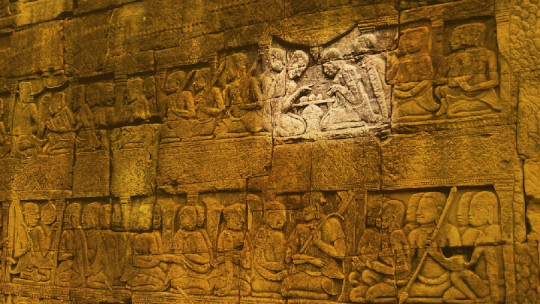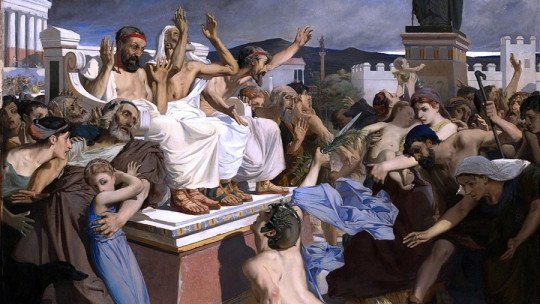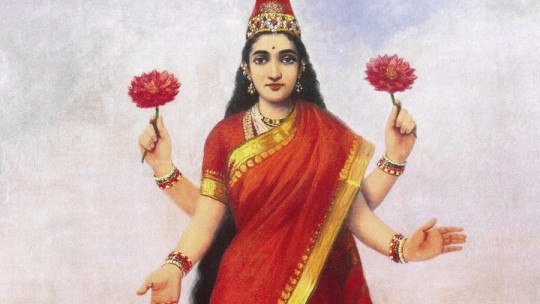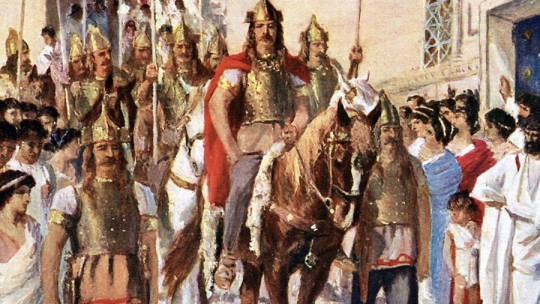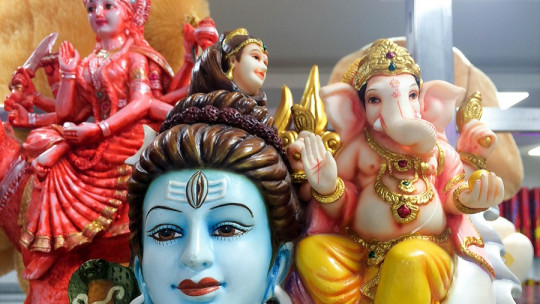The epic Ramayana, written in the 3rd century BC and one of the most important in India, tells that the ambitious king Vishmamitra coveted the magnificent cow owned by Vasishtha, a court sage. The cow, which was called Surabhi (or Kamadhenu according to other sources), was not only the most fabulous cow, but also possessed magical qualities. Wondered, Vishmamitra stole the animal and took it with him.
Aware that she and her owner were in danger, the cow Surabhi invoked her magical powers to raise an army of powerful warriors, who faced the troops of the usurper king. Finally, the greedy Vishmamitra was defeated and, repentant, he fled to the forest and became a saint.
This legend is nothing more than one of the many testimonies of the importance of the cow in Indian culture. This importance goes far beyond mere traditions, and the cow stands as an authentic sacred animal, whose sacrifice and consumption of meat is currently prohibited or restricted in most states of India. Violation of these laws is punishable by very high fines and even years in prison in much of the territory.
Why are cows sacred in India? Join us on a journey in which we will analyze where this sacredness so characteristic of the Indus Valley country could have arisen.
Why are cows sacred in India?
The origin of this sacredness is lost in the darkness of time. The story we have narrated is not the only one in the Hindu mythological corpus that includes the connection of the cow with the sacred; We find multiple stories that include Surabhi, the magical cow, in their plot.
Surabhi, the cosmic cow
The legend of Prince Satyavrat is very significant. This character turned out to be so evil that his own father, the king, punished him with a twelve-year exile. Satyavrat wandered through the forest, hungry and desolate, during the years of his sentence.
In the end, the hunger was so terrible that the prince killed Surabhi, the sacred cow, to satisfy his enormous appetite, even though he was aware that he was committing a serious mistake and that he would be punished for it. So it was. When the sage Vasishtha, the owner of the cow, learned of the sacrilege, he cursed Satyavrat and named him Trishanku, which means “the one of three sins,” alluding to the number of grave sins the prince had committed. Among them was, of course, the murder of Surabhi and the consumption of her sacred flesh.
Surabhi is the cosmic cow of Hinduism. From the ocean of milk, a huge milky sea that the gods stirred, the sacred cow appeared, also called Gau Mata. In the body of this primal cow all the gods dwell from then on : on its horns is Brahma, the creator god, while, for example, on the forehead is Agni, the god of fire and, on the nipples of the udders, Varuna.
This may be one of the reasons why the concept of sacredness appeared with respect to this animal. If Surabhi (or Gau Mata) is the cosmic cow, the celestial body that shelters the divinities (which it nourishes and protects), the cow becomes an indispensable protective element for Hindu culture, so killing this animal It becomes sacrilege.
Indo-European connections
However, the Hindu religion is not the only one that has the figure of the primordial cosmic cow to its credit. In fact, this element is present in practically all cultures that come from the ancient Indo-Europeans. This is the case of Indian culture, but also of ancient Greek and Scandinavian culture.
It is not necessary to remember the abundance of Greek myths in which the cow appears. We can cite, for example, the abduction of Io by the always lustful Zeus, whom the god turns into a cow so that his wife Hera does not suspect him. But, above all, where we find a completely indisputable similarity with the Hindu story of the primal cow is in ancient Scandinavian mythology: in the beginning, the fusion of ice (Níflheim) with fire (Múspellheim) gave as fruit Authumla or “Great Nurse”, the original cow from whose udders flow 4 rivers of milk that, by the way, fed Ýmir, the giant from whose body the world was created.
Even in peoples that have nothing to do with Indo-European culture we find a strong devotion to the cow as a sacred animal In ancient Egypt, Nut, the goddess of the sky, was often represented as a celestial cow, in a very clear relationship with the Hindu and Scandinavian cosmic cow. On the other hand, the goddess Hathor, protector of childbirth, motherhood and fertility, was personified as a woman with the head of a cow or with a headdress of bovine horns, among which was often a moon, a female symbol. since very old. In short, it is evident that the cow has been a very important animal in ancient religions, and not only in those of Indo-European origin. Perhaps the explanation can be found in the great importance that livestock had for the first agricultural communities, since they were the guarantor of their most immediate survival.
A cultural phenomenon with practical reasons?
It is not surprising that the cow is an essential element in the mythology of many peoples. We must keep in mind that, during the Bronze Age, when agriculture was consolidated and expanded, milk consumption was widespread. Animal milk was a guarantor of survival , since poor harvests could cause intense famines that could only be alleviated with the product obtained from livestock. Milk provides proteins and vitamins in abundance, and its consumption could mean death or survival.
This is why, soon, the cow began to be seen as the universal nurse, the giver of life par excellence. A parallel was established between the cow that, through its udders loaded with milk, nourishes hungry humanity, as the mother breastfeeds her child. Thus, the cow also became a symbol of motherhood, protector of childbirth and human fertility. We have already commented how, in ancient Egypt, Hathor, the cow-goddess, was the lady who helped with the process of giving birth, so all Egyptian women kept her in mind in their prayers, not only with a view to having a good birth, but also to produce enough milk to raise their little ones.
It is quite possible that the sacredness of the cow in India is based on quite practical reasons. Many authors maintain that it was precisely the importance of this animal for survival that motivated the ban on its sacrifice to be imposed over the years. Milk is extracted from the cow, which is used to produce butter and other dairy products, and killing the animal means ending the source of the food.
Not only that; In India, cow products are used in many aspects of daily life Bovine excrement produces the fertilizer necessary for the proper growth of crops and is also an important factor in producing fuel. In many regions of India, especially in rural areas, cow dung is used for combustion in household kitchen stoves.
In this context, where everything the cow produces becomes so important for daily survival, it is logical that the sacrifice of this cow becomes something inconceivable, and it is also logical that its figure receives respect and adoration.
The cow, an animal that was not always sacred
Or, better said, we could say “that it was not always respected.” Because in the sacred Hindu texts, the Vedas, we find certain contradictions in this regard. Although many of them speak of the consumption of beef as a taboo, others specify the importance of ritual slaughter and, related to this, the consumption of meat.
This apparent contradiction is explained by the evolution that Indian culture underwent over the millennia. We have already commented that the Indus culture comes from the Indo-European peoples, a series of human communities of common but uncertain origin that spread across the Indian subcontinent part of Asia and, above all, Europe.
Historians of religions, including the prestigious Mircea Eliade (1907-1986), have established that it is most likely that these people had an atmospheric pantheon; In other words, they worshiped gods and goddesses related to natural phenomena (rain, wind, fire…). The gods of the Hindu pantheon would come from these ancestral gods, and also those from ancient Greek, Roman and Scandinavian mythologies.
The Hindus of the first Vedic era would have culturally vestiges of these Indo-Europeans and, therefore, its rituals would still be connected with those of the Indo-European culture. These rituals involved the sacrifice of animals to the gods (whose rites are described in the Vedas), which were located in open spaces (in sight of these “atmospheric” gods) and accompanied by ritual fire.
Ritual sacrifice could be private or public. In the first case, it was carried out at the request of a “sacrificer” (the yajamana), and it was done on the domestic altar. The second case was much more expensive, since public sacrifices could last days or even months and, therefore, could only be sponsored by figures such as the king or wealthy families.
The parallelism with Greek and Roman sacrificial rituals is more than evident. Let us not forget that these peoples have a common remote origin, the culture of the Indo-Europeans. Thus, the ancient inhabitants of the Indus Valley offered butter, meat and milk to the fire; The most precious thing they owned went to the bosom of the gods in exchange for protection.
When did animal sacrifice start to be seen as something impure? It is estimated that, around the year 1000 AD, the veneration of the sacred cow was already completely widespread in India, and the consumption of its meat had already become prohibited. The strong and gradual “internalization” to which the old religion was subjected may have had something to do with all of this. Let us not forget that, from an early date, the practice of meditation was already widespread and, with it, the belief in the reincarnation of souls. AND, If a soul can reincarnate into any being, how can it be right to kill and consume flesh?
Indian culture and non-violence
Closely linked to all this is the culture of non-violence or ahimsa, which is found throughout the country and is the opposite of himsa, violence. This concept goes beyond peace between humans and extends to all creatures of creation.
In the formation of this idea so linked to the culture of India are Buddhism and Jainism, two of the most important religions besides Hinduism. In fact, one of the main guidelines of Jainism is ahimsa; in it Acaranga Sutraone of his most important texts, it is said that everything that breathes (and, therefore, that lives), should not be killed or mistreated
In Hinduism, we find mention of ahimsa in the Upanishads (800 BC), precisely at the time when this philosophy of non-violence was being forged and the Vedic-Indo-European ritual sacrifice was definitively left behind. In a context where every living being must be respected, the consumption of animal meat is of course out of place.
One of the greatest promoters of ahimsa was Mahatma Gandhi (1869-1948), who introduced this philosophy to the West. The hippie movement of the 60s picked it up with real vigor and, later, ahimsa influenced the formation of currents that defend nature and animals.


